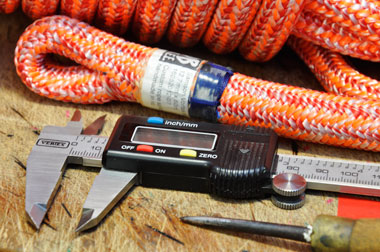Climbing ropes are getting more and more complex, often produced for very specific technical tree climbing applications where the operational expectation (of the line) is highly targeted.
Responsible rope manufacturers do provide in-depth data, detailing all the relevant features of each line in their portfolio but, for tree climbers searching for the right information, this can be akin to finding the proverbial needle in the haystack - see previous blog post on the subject here.
It's little wonder then that tree climbers resort to myths and arborist legends for direction - listed below are Treetools five favorites we hear on a daily basis:
1) Fat ropes for fat, old climbers!
Not true. Larger diameter ropes attract a wide variety of climbers.
Yes, the older, heavier guys do like something to hold onto but there are plenty of skinny tree climbers wrapping their boney little fingers around Samson Vortex… and their hands are thankful for the relief.
Samson Vortex was one of the surprises for 2012 - see previous blog post here . Vortex may not appeal to technical climbers but this new line has built up a very loyal following over the last few months.
A true half inch (12.7mm) Vortex is proving to be robust in the field, even when natural crotching, yet it remains easy to knot and is gentle on the hands (as you could imagine).
Tree climbers using traditional hitch systems find these benefits far outweigh the sideways glance they get from those less informed.
2) 11mm climbing lines are for advanced users!
Just as 'fat ropes for fatties' thin ropes for advanced climbers is equally incorrect.
Climbers of all sizes and weight climb on 11mm Yale Blaze and Samson Velocity .
Yes, it's true, 11mm diameter lines are better suited to some mechanical devices, and climbers using this equipment are more than likely to be considered 'advanced'.
But that does not necessarily negate the use of thinner diameter lines by tree climbers using traditional hitch systems.
Plenty of 'newbie' climbers sing the praises of Blaze or Velocity simply because that was the first line they climbed on. They got used to the thin diameter from day one so there is no perceived problem.
It comes down to a matter of personal preference.
3) Long ropes reflect the quality of the climber!
This one is a real beauty (in a perverse kind of way Treetools would love it to be true).
Sure, competent climbers climb big trees, but even the pros will have a shorter line for climbing smaller trees.
If you spend all day climbing 15m trees, a 60m line will end up being a nuisance.
Not only do you have to manage all that extra rope, along with making sure the groundie doesn't toss it into the chipper while you are not looking, but you are bound to get hockles and twists if the tail is not allowed to release the torsion produced by your friction hitch or descender (if you happen to use one).
A shorter rope for smaller trees allows you to run out the twists rather than storing them as hockles in your rope bag!
A long rope does not necessarily mean you are a better climber.
The reality is, if a nubbin is climbing a small tree on an extra-long line you'll be spotted immediately for what you are.
Of course, do not think about tackling a big tree with a short rope - at least, not without a stopper knot!
4) The only difference between the ropes is the fancy colors!
Yeah right!
This silly statement usually stems from climbers who hark back to the good ol' 3-strand days. Nothing wrong with traditional ideas but things have changed and rose tinted glasses are no longer mandatory.
Fibre pigmentation does influence the behavior of the rope. Apart from this important fact, all ropes behave differently regardless of colour.
Anecdotal evidence suggests rope with identical manufacturing specifications, albeit an alternative colour, will perform differently.
They also present unique splicing characteristics.
Climbing lines are available in diameters 10mm through to 13mm, 3-strand to 48-strand construction with fibers made from nylon and polyester to Vectran and Dyneema.
There is far more to a rope than simply its fancy color! (Please don't mention this one again)
5) All ropes get pigtails!
Well… yes and no.
Cheap ropes can twist and kink. To keep manufacturing costs down these ropes are braided with Z-twist strands only. Treetools does not stock this kind of rope.
Good quality rope manufacturers (think Samson, Teufelberger, Yale) use the correct balance of clockwise Z-twist and counter-clockwise S-twist strands to produce a torsion-neutral climbing line with no inherent spin or kink.
But… all ropes do produce pigtails if not handled correctly.
Rope peeled off the reel incorrectly will hockle. And there's a right and a wrong way to coil a rope.
Different friction hitches produce differing levels of twist.
And as noted above, long lines used on small trees, where the twist is not allowed to run-out out freely, have the tendency to hockle and pigtail.
Excessive use of the Fig 8 descender will also introduce kinks (one turn of the line for every 3m of descent according Rock and Ice Magazine).
Even storage can be an issue.
The 'Butterfly Coil' is the best method for coiling a kink-free rope - most other coil methods introduce twist without you even being aware of the problem (until you come to next use it).
An alternative for arborists is to flake loosely into a rope bag.

Treetools fully appreciates the above post covers many 'technical' rope issues. Brevity excludes us from expanding on the topic of rope manufacture here but will endeavor to provide more in-depth coverage in future posts.
